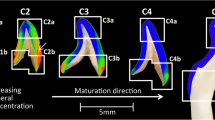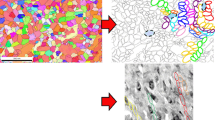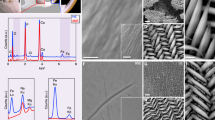Summary
Ribbon-like crystals, from developing enamel of human fetuses, were studied by high resolution electron microscopy. These crystals were classically described as the first organized mineral formed during amelogenesis. They were characterized by a mean width-to-thickness ratio (W.T-1) of 9.5, and 40% were bent. On lattice images we noted the presence of the central dark line (CDL) associated with white spots. Both structures were found in crystals with a minimum thickness of 8–10 nm. CDLs were localized in the center of the crystals and seemed to be linked to the initial growth process, but their exact structure and function were not fully determined. We were able to study the structure of the ribbon-like crystals with a Scherzer resolution close to 0.2 nm. The good correspondence between experimental and computed images showed that their structure was related to hydroxyapatite (HA). In addition, the presence of ionic substitutions and deficiencies were also compatible with HA. In this study, about 50% of the crystals showed structural defects. Screw dislocations were the most often noted defects and were observed within crystals aligned along five different zone axes. Low- and high-angle boundaries were also detected. Low-angle boundaries, found in the center of the crystals, could thus be related to CDLs and be implicated in the nucleation step of crystal formation, whereas high-angle boundaries could result from the fusion of ribbon-like crystals. Such mechanisms could induce an acceleration of the growth in thickness of the crystal observed during the maturation stage of amelogenesis.
Similar content being viewed by others
References
Sicher H (1962) Orban's oral histology and embryology. Mosby, Saint-Louis
McConnell D (1960) Recent advances in the investigation of the crystal chemistry of dental enamel. Arch Oral Biol 3:28–34
Featherstone JDB, Mayer I, Driessens FCM, Verbeeck RMH, Heijligers HJM (1983) Synthetic apatites containing Na, Mg, and CO3 and their comparison with tooth enamel mineral. Calcif Tissue Int 35:169–171
Elliott JC (1961) The infared spectrum of the carbonate ion in carbonate-containing apatites (abstract). J Dent Res 40:1284
Emerson WH, Fischer EE (1962) The infrared absorption spectra of carbonate in calcified tissues. Arch Oral Biol 7:671–683
Frank RM, Sognaes RF, Kern R (1960) Calcification of dental tissues with special reference to enamel ultrastructure. In: Sognaes RF (ed) Calcification in biological systems. Am Assoc Adv Science, publication no 64, Washington, pp 169–175
Selvig KA (1972) The crystal structure of hydroxyapatite in dental enamel as seen with the electron microscope. J Ultrastruct Res 41:369–375
Voegel JC, Frank RM (1974) Microscopie electronique de haute résolution du cristal d'apatite d'email humain et de sa dissolution carieuse. J Biol Buccale 2:39–50
Nelson DGA, McLean JD, Sanders JV (1983) A high resolution electron microscope study of synthetic and biological carbonated apatites. J Ultrastruct Res 84:1–15
Brès EF, Barry JC, Hutchison JL (1984) A structural basis for the carious dissolution of apatite crystals of human tooth enamel. Ultramicroscopy 12:367–372
Brès EF, Barry JC, Hutchison JL (1985) High resolution electron microscope and computed images of human tooth enamel. J Ultrastruct Res 90:261–274
Elliott JC, Holcomb DW, Young RA (1985) Infrared determination of the degree of substitution of hydroxyl by carbonate ions in human dental enamel. Calcif Tissue Int 37:372–375
Glimcher MJ, Brickley-Parsons D, Levine PT (1977) Studies of enamel proteins during maturation. Calcif Tissue Res 24:259–270
Fincham AG, Bessem CC, Lau EC, Pavlova Z, Shuler C, Slavkin HC, Snead ML (1991) Human developing enamel proteins exhibit a sex-linked dimorphism. Calcif Tissue Int 48:288–290
Robinson C, Kirkham J, Weatherell JA, Richards A, Josephsen K, Fejerskov O (1988) Mineral and protein concentrations in enamel of the developing permanent porcine dentition. Caries Res 22:321–326
Strawich E, Glimcher MJ (1989) Major “enamelin” protein in enamel of developing bovine teeth is albumin. Connect Tissue Res 22:111–121
Aoba T, Moreno EC (1990) Changes in the nature and composition of enamel mineral during porcine amelogenesis. Calcif Tissue Int 47:356–364
Rey C, Shimizu M, Collins B, Glimcher MJ (1990) Resolution-enhanced fourier transform infrared spectroscopy study of the environment of phosphate ions in the early deposits of a solid phase of calcium-phosphate in bone and enamel, and their evolution with age I: investigation in the ν4PO4 domain. Calcif Tissue Int 46:384–394
Chickerur NS, Tung MS, Brown WE (1980) A mechanism for incorporation of carbonate into apatite. Calcif Tissue Int 323: 55–62
Rönnholm E (1962) The amelogenesis of human teeth as revealed by electron microscopy II: the development of the enamel crystallites. J Ultrastruct Res 6:249–303
Daculsi G, Kerebel LM (1978) High resolution electron microscope study of human enamel crystallites: size, shape and growth. J Ultrastruct Res 65:163–172
Cuisinier FJG, Glaisher RW, Voegel JC, Hustchison J, Brès E, Frank RM (1991) Compositional variations in apatites with respect to preferential ionic extraction. Ultramicroscopy 36:297–305
Cuisinier FJG, Voegel JC, Yacaman J, Frank RM (1992) Structure of initial crystals formed during human amelogenesis. J Crystal Growth 116:314–318
Scherzer O (1949) The theoretical resolution limit of the electron microscope. J Appl Phys 20:20–29
Stadelmann P (1987) EMS—a software package for electron diffraction analysis and HREM image simulation in material science. Ultramicroscopy 21:131–146
Cowley JM (1959) The electron optical imaging of crystal lattices. Acta Crystallogr 12:367
Kay MI, Young RA, Posner AS (1964) Crystal structure of hydroxyapatite. Nature 204:1050
Weiss MP, Voegel JC, Frank RM (1981) Enamel crystallite growth: width and thickness study related to the possible presence of octocalcium phosphate during amelogenesis. J Ultrastruct Res 76:286–292
Voegel JC (1978) Le cristal d'apatite des tissue osseux et dentaires et sa destruction pathologiques. Thèse d'Etat de Doctorat ès Sciences, Université Louis Pasteur, Strasbourg
Brown WE (1962) Octocalcium phosphate and hydroxyapatite. Nature 196:1048–1055
Brown WE (1965) A mechanism for growth of apatitic crystals. In: Stack MV, Fearnhead RW (eds) Tooth enamel I. John Wright Ltd, Bristol, pp 11–14
Voegel JC, Weiss MP, Frank RM (1981) High resolution electron microscopic technique applied to the detection of distortions in apatite crystallites during amelogenesis. J Biol Buccale 9:183–191
Van der Merwe JH (1979) The role of lattice misfit in epitaxy. In: Vanselow R (ed) Chemistry and physics of solid surfaces, vol II. IRC Press Inc, Florida, pp 129–151
Marshall AF, Lawless KR (1981) TEM study of the central dark line in enamel crystallites. J Dent Res 60:1773–1782
Nakahara H, Kakei M (1983) The central dark line in developing enamel crystallite: an electron microscopic study. Bull Josai Dent Univ 12(1):1–7
Nakahara H, Kakei M (1984) TEM observations on the crystallites of dentin and bone. Bull Josai Dent Univ 13(2):259–263
Bres EF, Waddington WG, Voegel JC, Barry JC, Frank RM (1986) Theoretical image simulation of a dark contrast line (DCL) in twinned apatite bicrystals and its possible correlation with the chemical properties of human dentine and enamel crystals. Biophys J 1105–1193
Brès EF, Hutchison JL, Voegel JC, Frank RM (1990) Observation of a low angle grain boundary in tooth enamel crystals using Colloque de physique C1 (suppl 1) 51:97–102
Takuma S, Tohda H, Tanaka N, Kobayashi T (1987) Lattice defects and carious dissolution of human enamel crystals. J Electron Microsc 36:387–391
Spence JCH (1981) Experimental high-resolution electron microscopy. Oxford University Press, Oxford
Hirth JP, Lothe J (1982) Theory of dislocations, 2nd ed. Wiley, New York
Nelson DGA, McLean JD, Sanders JV (1982) High-resolution electron microscopy of electron irradiation damage in apatite. Radiat Eff Lett 68:51–56
Tohda H, Takuma S, Tanaka N (1987) Intracrystalline structure of enamel crystals affected by caries. J Dent Res 66(11):1647–1653
Gai PL, Goringe MJ, Barry JC, Waddington WG, Boyes ED (1985) HREM image contrast from supported metal particles. Inst Phys Conf Ser 78:485–488
Brès EF, Voegel JC, Frank RM (1989) High-resolution electron microscopy of human enamel crystals. J Microscopy 160:183–201
Perdikatsis B (1991) X-ray powder diffraction study of francolite by the Rietveld method. 1st Eur Powder Diffraction Conf, Munich
Sydney-Zax M, Mayer I, Deutsch D (1991) Carbonate content in developing human and bovine enamel. J Dent Res 70(5):913–916
Brown WE, Schroeder LW, Ferris JS (1979) Interlaying of crystalline octocalcium phosphate and hydroxyapatite. J Phys Chem 83:1385–1388
Cuisinier FJG, Steuer P, Frank RM, Voegel JC (1990) High resolution electron microscopy of young apatite crystals in human fetal enamel. J Biol Buccale 18:149–154
Vere AW (1987) Crystal growth: principles and progress. Plenum Press, New York
Hull D (1975) Introduction to dislocations, 2nd ed. Pergamon, Oxford
Author information
Authors and Affiliations
Rights and permissions
About this article
Cite this article
Cuisinier, F.J.G., Steuer, P., Senger, B. et al. Human amelogenesis I: High resolution electron microscopy study of ribbon-like crystals. Calcif Tissue Int 51, 259–268 (1992). https://doi.org/10.1007/BF00334485
Received:
Revised:
Issue Date:
DOI: https://doi.org/10.1007/BF00334485




